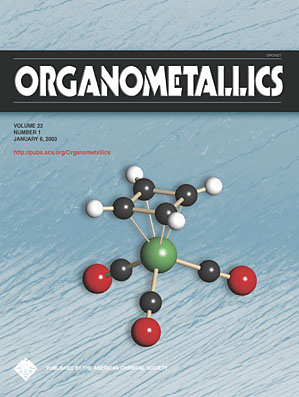







|
|
|
Journal
Publications |
|
Ruthenium Complexes of the
1,4-Bis(diphenylphosphino)-1,3-butadiene Bridged Diphosphine
1,2,3,4-Me4-NUPHOS: Solvent Dependent Interconversion of Four- and
Six-Electron Donor Coordination and Transfer Hydrogenation Activity.
Simon Doherty, Colin R. Newman,
Christopher Hardacre, Mark Nieuwenhuyzen, and Julian G. Knight,
Organometallics, 2003,
22,
1452. |
|
Abstract: In chloroform, [RuCl2(nbd)(py)2]
(1) (nbd = norbornadiene; py = pyridine) reacts with
1,4-bis(diphenylphosphino)-1,2,3,4-tetramethyl-1,3-butadiene (1,2,3,4-Me4-NUPHOS)
to give the dimer [Ru2Cl3(h4-1,2,3,4-Me4-NUPHOS)2]Cl
(2a), whereas, in THF [RuCl2(1,2,3,4-Me4-NUPHOS)(py)2]
(3) is isolated as the sole product of reaction. Compound 2
exists as a 4:1 mixture of two noninterconverting isomers, the major
with C1 symmetry and the minor with either Cs
or C2 symmetry. A single-crystal X-ray analysis of [Ru2Cl3(h4-1,2,3,4-Me4-NUPHOS)2][SbF6]
(2b), the hexafluoroantimonate salt of 2a, revealed that
the diphosphine coordinates in an unusual manner, as a
h4-six-electron donor, bonded
through both P atoms and one of the double bonds of the butadiene
tether. Compounds 2a and 3 react with 1,2-ethylenediamine
(en) in THF to afford [RuCl2(1,2,3,4-Me4-NUPHOS)(en)]
(4), which rapidly dissociates a chloride ligand in chloroform to
give [RuCl(h4-1,2,3,4-Me4-NUPHOS)(en)][Cl]
(5a). Complexes 4 and 5a cleanly and quantitatively
interconvert in a solvent-dependent equilibrium, and in THF 5a
readily adds chloride to displace the h2-interaction
and re-form 4. A single-crystal X-ray structure determination of
[RuCl(h4-1,2,3,4-Me4-NUPHOS)(en)][ClO4]
(5b) confirmed that the diphosphine coordinates in an
h4-manner as a facial six-electron
donor with the h2-coordinated
double bond occupying the site trans to chloride. The
h4-bonding mode can be readily
identified by the unusually high-field chemical shift associated with
the phosphorus atom adjacent to the h2-coordinated
double bond. Complexes 2a, 2b, 4, and 5a
form catalysts that are active for transfer hydrogenation of a range of
ketones. In all cases, catalysts formed from precursors 2a and
2b are markedly more active than those formed from 4 and
5a. |
| |
|
|
|



